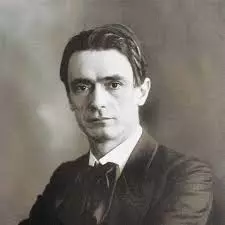 Rudolf Steiner was an Austrian scientist, philosopher and artist who lived from 1861-1925. His interests were not only in education, but also in a wide range of fields such as medicine, agriculture, nutrition, social renewal, the environment. One of his beliefs was that humanity needs to work organically in co-operation with nature, not against it. He sounded warning bells about many issues, such as sustainability and depletion of human and natural resources, which are of wide concern today.
Rudolf Steiner was an Austrian scientist, philosopher and artist who lived from 1861-1925. His interests were not only in education, but also in a wide range of fields such as medicine, agriculture, nutrition, social renewal, the environment. One of his beliefs was that humanity needs to work organically in co-operation with nature, not against it. He sounded warning bells about many issues, such as sustainability and depletion of human and natural resources, which are of wide concern today.
Steiner first began speaking publicly about spiritual experiences and phenomena in his 1899 lectures to the Theosophical Society. By 1901 he had begun to write about spiritual topics, initially in the form of discussions of historical figures such as the mystics of the Middle Ages. By 1904 he was expressing his own understanding of these themes in his essays and books, while continuing to refer to a wide variety of historical sources.
A world of spiritual perception is discussed in a number of writings which I have published since this book appeared. The Philosophy of Freedom forms the philosophical basis for these later writings. For it tries to show that the experience of thinking, rightly understood, is in fact an experience of spirit. – (Steiner, Philosophy of Freedom, Consequences of Monism)
Rudolf Steiner’s Six Basic Exercises
1. Control of thought
The first practice is about gaining control over what you think. Take a simple, human-made object like a pen or glass and spend five minutes focusing on it. Describe the object to yourself, notice its shape, colour, weight, smell and so on. Think about how this object was made, where the materials came from. If your mind wanders, gently bring your focus back to the object.
2. Control of will
The next is for gaining control over what you do. Choose a simple action to perform each day at a particular time. It should be something you wouldn’t ordinarily do; it can even be a little odd. For example, draw a circle on the door with your left index finger five times. Make it a duty to perform this action at that time each day. As you progress, additional tasks can be added at other times.
3. Equanimity
This is about building awareness of your emotional response to the world and calming extreme feelings. When something happens that invokes a particular reaction from you, the work is to observe that response, feel it in its entirety and neutralise it internally with an opposing emotion.
4. Positivity
Thinking and feeling are combined here to develop a positive attitude to the world. It requires paying attention to someone or something around you in a given moment and seeing the good, praiseworthy and beautiful in it.
5. Open-mindedness
Next is for becoming more open to situations and ideas, and never letting expectations based on the past close your mind to the lessons of the moment. It involves being in a state of curiosity and wonder at even the most mundane of things, like a leaf falling from a tree, and keeping open the possibility of something unexpected happening in a given situation.
6. Harmony
The final exercise is to make a harmonious whole of thought, feeling and action. It involves finding a balanced relationship between the five exercises, practising each one regularly and in different combinations with one another, thus being able to move between them more dynamically.
“If we do not believe within ourselves this deeply rooted feeling that there is something higher than ourselves, we shall never find the strength to evolve into something higher.” – Rudolf Steiner

![]()

